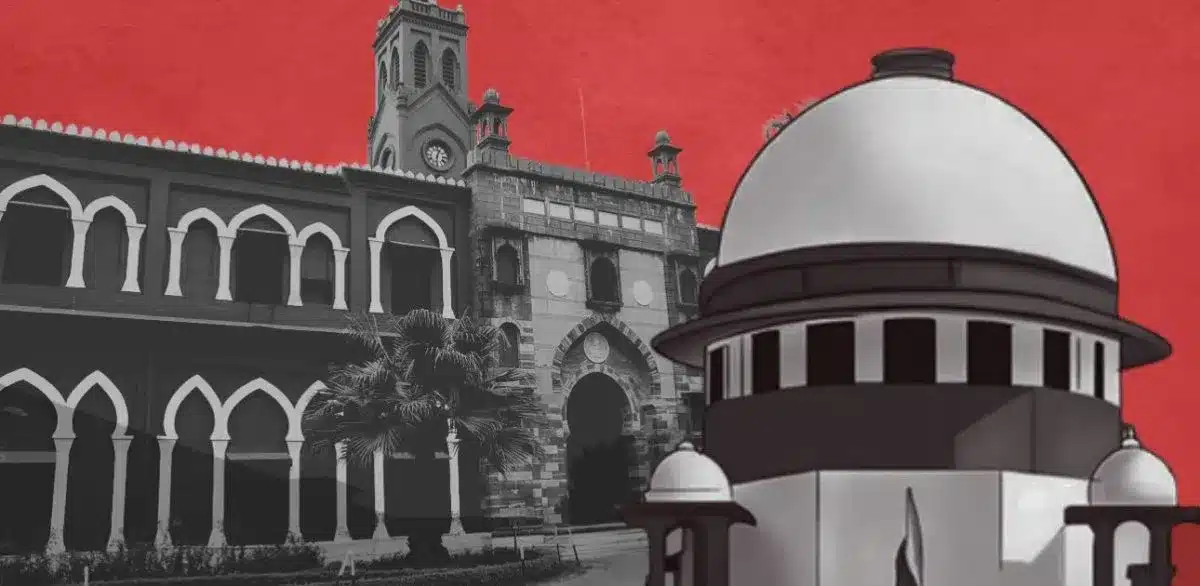What’s in today’s article?
- Why in News?
- Background of the AMU Minority Status Case
- Constitutional Protections and Benefits of MEIs
- SC’s Criteria for Determining MEI Status
- Two-Fold Test to Establish Minority Status
- Implications of SC Determining MEI Status Test
- Conclusion
Why in News?
- Without determining whether Aligarh Muslim University (AMU) is a minority institution or not, a 7-judge bench of the Supreme Court overruled by a 4:3 majority a 1967 judgment by a 5-judge bench in Azeez Basha case.
- The majority opinion laid down elaborate parameters for testing the minority character of an institution and tasked a regular bench to adjudicate the 57-year-old controversy based on the parameters.
Background of the AMU Minority Status Case:
- AMU’s transformation from MAO college (1920)
- The Muhammadan Anglo-Oriental (MAO) college, established in 1877, was converted to AMU in 1920 by a central legislature Act.
- The government argued this conversion changed its minority status, which became a pivotal issue in later legal debates.
- Azeez Basha case (1967): The SC held that AMU was not established by the Muslim community but by a central legislature Act in 1920, disqualifying it as a minority institution under Article 30 of the Constitution.
- Government amendments and legal developments (1981-2006):
- 1981: An amendment to the AMU Act declared AMU was created by the Muslim community for their educational advancement.
- 2005: AMU introduced 50% reservation for Muslims in postgraduate medical courses.
- 2006: The Allahabad HC ruled against AMU’s minority status, annulling the 1981 amendment and the 50% reservation policy.
- SC referral (2019): The issue was brought before the Supreme Court, and in 2019, it was referred to a seven-judge Bench.
Constitutional Protections and Benefits of MEIs:
- Article 30: Under Article 30(1), minorities have the right to establish and administer educational institutions.
- Article 15(5): MEIs are granted special privileges, such as control over admissions and staff hiring, and exemption from reservations for SCs and STs under this provision.
- Benefits of minority status: Minority institutions can reserve up to 50% seats for minority students and enjoy autonomy in administration, fostering cultural and linguistic diversity.
SC’s Criteria for Determining MEI Status:
- The SC identified the following:
- The institution’s purpose should primarily aim to conserve minority language and culture.
- Minority institutions may admit non-minority students without losing their minority status.
- Secular education does not undermine minority character.
- Government-aided institutions cannot compel religious instruction; those fully state-funded cannot offer it.
- Test for determining minority character: The SC devised a two-step test to identify whether an institution holds a minority character.
Two-Fold Test to Establish Minority Status:
- Establishment:
- Courts must investigate the origin and purpose of an institution’s establishment, identifying community involvement in its formation.
- Proof of establishment includes letters, funding records, and communications affirming that the institution’s aim was predominantly for the minority community’s benefit.
- Administration:
- MEIs are not obligated to appoint only minority members to administrative roles. However, administrative setup should reflect minority interests.
- For pre-1950 institutions, courts must review whether the administration affirmed the minority’s interest on the Constitution’s commencement date.
Implications of SC Determining MEI Status Test:
- Administrative autonomy affirmed: This is seen as a significant development for institutions like St Stephen’s College, which is currently in a dispute with Delhi University (DU) over its principal’s reappointment process.
- Reignites minority status debate:
- The ongoing legal questions surrounding Jamia Millia Islamia’s (JMI) minority status are closely connected to the AMU case.
- According to JMI’s standing counsel, the SC’s decision on AMU’s minority status will likely affect JMI’s case as both involve similar legal principles about institutions created by legislative acts.
Conclusion:
- The SC’s verdict brings AMU closer to securing its minority status by clarifying criteria for minority character under Article 30. However, the final determination of AMU’s status awaits further review.
- This landmark judgment sets a precedent for MEIs, preserving minority rights in India’s educational framework while ensuring alignment with constitutional provisions.
Q.1. Who established the Muhammadan Anglo-Oriental college?
Muhammadan Anglo-Oriental college was founded in 1875 by Sir Syed Ahmad Khan, initially as a primary school, with the intention of turning it to a college level institution.
Q.2. What is Article 15(5) of the Constitution of India?
Article 15(5) of the Constitution gives the state the power to make special provisions for the following groups: socially and educationally backward classes of citizens, scheduled castes, and scheduled tribes.
News: SC overturns 1967 verdict that nixed AMU’s minority status | IE | IE
Last updated on December, 2025
→ Check out the latest UPSC Syllabus 2026 here.
→ Join Vajiram & Ravi’s Interview Guidance Programme for expert help to crack your final UPSC stage.
→ UPSC Mains Result 2025 is now out.
→ UPSC Notification 2026 is scheduled to be released on January 14, 2026.
→ UPSC Calendar 2026 is released on 15th May, 2025.
→ The UPSC Vacancy 2025 were released 1129, out of which 979 were for UPSC CSE and remaining 150 are for UPSC IFoS.
→ UPSC Prelims 2026 will be conducted on 24th May, 2026 & UPSC Mains 2026 will be conducted on 21st August 2026.
→ The UPSC Selection Process is of 3 stages-Prelims, Mains and Interview.
→ UPSC Result 2024 is released with latest UPSC Marksheet 2024. Check Now!
→ UPSC Prelims Result 2025 is out now for the CSE held on 25 May 2025.
→ UPSC Toppers List 2024 is released now. Shakti Dubey is UPSC AIR 1 2024 Topper.
→ UPSC Prelims Question Paper 2025 and Unofficial Prelims Answer Key 2025 are available now.
→ UPSC Mains Question Paper 2025 is out for Essay, GS 1, 2, 3 & GS 4.
→ UPSC Mains Indian Language Question Paper 2025 is now out.
→ UPSC Mains Optional Question Paper 2025 is now out.
→ Also check Best IAS Coaching in Delhi

















